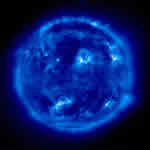What is . . the sun ?
The Transit of Venus The Sun Venus
The Sun
The Sun is a as a G2V type, main sequence star, also known as a yellow dwarf. It could be classified a very “ordinary” star, one of many billions in our Milky Way.
However, this star is in our own astronomical neighbourhood and we can view the Sun in ways we can do with no other celestial object. In particular, recent space-based solar satellites like the Solar and Heliospheric Observatory (or SOHO for short), have completely changed how we view the Sun by producing very spectacular detailed and dynamic solar images.
The Sun is the geometrical and gravitational centre of our Solar System, containing 99.8% of the System’s total mass. It would take 342 Earth-sized globes strung together to encircle the Sun while 1,300,000 crushed up Earths could fit inside the star. Some solar statistics are:-
Diameter: 1,390,000 km
Mass: 1.989x1030 kg
Temperature: 5800 K (surface)
15,600,000 K (core)
Chemical composition by atom: 92.1% hydrogen, 7.8% helium, 0.1% heavier elements (mainly carbon, nitrogen, oxygen, neon, magnesium, silicon and iron)
(see figure 1)
The star is built up from a series of different layers. At its core, our Sun is a natural nuclear fusion reactor with 700 million tonnes of hydrogen being converted into helium and energy every second. However, given the total mass of the Sun, it is believed that our star is still only half-way through it’s life cycle and will continue to shine for another 5 billion years.
As you move outwards from the Sun’s centre, you travel through the radiative zone, the convection zone (where it is believed that the Sun’s magnetic field is generated) and then reach the photosphere. This thin skin around the Sun (it is only a few hundred km thick at a temperature of 5800K) is the part of the star where visible light originates. Sunspots are seen littering the photosphere – cool, dark regions of strong solar magnetic field. The number of sunspots on the Sun changes with time – our star follows an approximate 11 year activity cycle, passing through times of little or no sunspots (solar minimum) through to times of many sunspots (solar maximum).
(see figure 2)
Above the photosphere is the chromosphere (at a temperature of 4000K).
(see figure 3)
Above this layer is the outer atmosphere of the star or the corona. Visible as a bright halo around the moon during a solar eclipse, this tenuous atmosphere is at an average temperature of two million degrees. Why corona is so hot is still not fully understood but it is believed that the Sun’s magnetic field is responsible for releasing excess heat into this part of the atmosphere. At these temperatures, the material in the corona is plasma.
(see figure 4)
However, we do not have to wait for a solar eclipse to observe the corona. SOHO allows us to view the Sun in the part of the electromagnetic spectrum known as the extreme ultraviolet. Amazing high rise arches are seen stretching out into the corona. It is thought that these are due to the magnetic field channelling the electrified gases along huge twisted magnetic pipes.
(see figure 5)
The Sun is continuously streaming material out into interplanetary space; this is known as the solar wind. On top of that, sometimes the strong magnetic regions become unstable and erupt, sending huge quantities of plasma shooting out from the star.
(see figure 6)
These solar storms (or coronal mass ejections) can release up to ten billion tonnes of ionised gas, rocketing out from the Sun at speeds up to 1000 km/s. They are often (but not always) associated with solar flares, massive explosions of magnetic energy releasing about five thousand atom bombs worth of power in a matter of minutes.
Solar storms and flares can have a profound impact on the Earth including the creation of beautiful aurora through to detrimental effects like power line surges, radio interference and damaging fragile satellite electronics.
(see figure 7)
One thing to note: our Sun will eventually burn up its supply of hydrogen fuel. Like other similar stars, our Sun’s outer layers will expand outwards as it evolves into a red giant enveloping the Earth. Finally when all the helium fuel has been depleted, the Sun will shed its outer gaseous layers to form a nebula while the Sun’s inner layers collapse to create a white dwarf. But don't worry - this won't occur for another 4 to 5 billion years!
|







